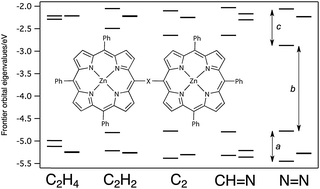A systematic theoretical study of the electronic structures of porphyrin dimers: DFT and TD-DFT calculations on diporphyrins linked by ethane, ethene, ethyne, imine, and azo bridges†
Abstract
Theoretical calculations of the geometries, electronic structures and electronic absorption spectra of a series of covalently-linked porphyrin dimers are reported. The diporphyrins comprise 5,10,15-triphenylporphyrinatozinc(II) (ZnTriPP) units linked through the meso carbons by two-atom bridges, namely 1,2-ethanediyl (1), trans-1,2-ethenediyl (2), ethynediyl (3), 1,2-iminomethenediyl (4), and trans-diazenediyl (5). The structures were optimised in toluene solvent by Density Functional Theory (DFT), using the integral equation formalism variant of the polarizable continuum model. The calculations were performed using the B3LYP functional and the 6-31G(d,p) basis set. The complete molecules were modelled, with no substitution of smaller groups on the periphery. In parallel, the compounds 2–5 were prepared by known or novel synthetic routes, to enable comparisons of experimental electronic absorption spectra with those calculated using time dependent-DFT at the same level of theory. As the ethane dimer 1 is not yet synthetically accessible, the model monomer meso-2-phenylethylZnTriPP was used for comparisons with the theoretical predictions. The results form a self-consistent set, enabling for the first time legitimate comparisons of the electronic structures of the series, especially regarding the degree to which the porphyrin π-systems interact by conjugation across the bridges. The theoretical calculations of the electronic transitions match the observed spectra in toluene to a remarkable degree, especially with respect to the peak maximum of the Q band, which represents to a large degree the energy of the HOMO–LUMO transition. The imine 4 is intrinsically polar due to the asymmetric bridge, and the HOMO is located almost exclusively on the ZnTriPP unit attached to the nitrogen of the imine, and the LUMO on the C-attached ring. Thus the Q-band transition is mapped as a comprehensive charge-transfer from the former ring to the latter. This may have consequences for the non-linear optical properties of the system. The azoporphyrin 5 exhibits the largest splittings between the interacting MOs via the conjugated bridge, vindicating a prediction by Anderson and co-workers in 2002, and confirmed experimentally by our synthesis of 5. The collected results also indicate that this level of theory is more than adequate as a model with which to handle these large delocalised molecules.


 Please wait while we load your content...
Please wait while we load your content...